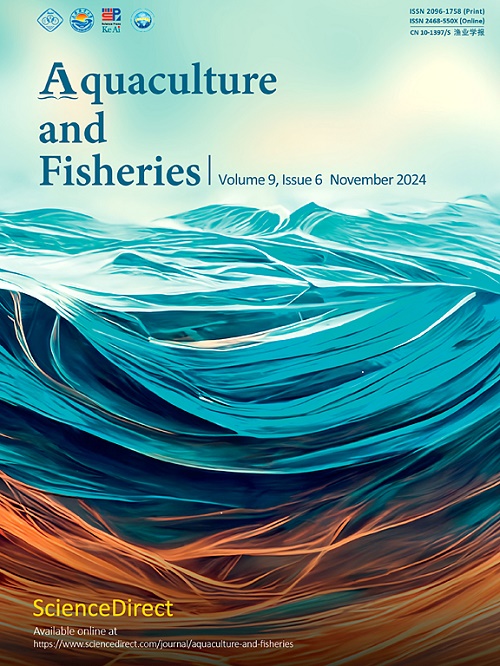The difference of the composition and digestive enzymes of gut microbiome in herbivorous blunt snout bream (Megalobrama amblycephala) and carnivorous largemouth bass (Micropterus salmoides)
Q1 Agricultural and Biological Sciences
引用次数: 0
Abstract
Blunt snout bream (Megalobrama amblycephala) and largemouth bass (Micropterus salmoides) are a herbivorous and a carnivorous freshwater fish species respectively. These fish possess distinct intestinal microorganisms and digestive enzymes that play a vital role in nutrient digestion. As a result, herbivorous and carnivorous fish exhibit significant differences in their digestive strategies. In this study, we investigated the compositions and functions of the gut flora of herbivorous M. amblycephala and carnivorous M. salmoides by 16S rRNA sequencing. PCoA analysis revealed that the gut flora of M. amblycephala and M. salmoides formed two distinct clusters. OTU analysis found that M. amblycephala and M. salmoides shared a small number, but high abundance, of core microorganisms, and that a large number of microorganisms differed at the phylum and genus levels between the two species. The cellulose-degrading bacteria Longivirga, Flavobacterium, Clostridium_sensu_stricto_12, and Bacillus were dominant in M. amblycephala, while protein-degrading bacteria Clostridium_sensu_stricto_1, Lactococcus, Streptococcus and Proteiniclasticum were dominant in M. salmoides. PICRUSt analysis showed significant differences in carbohydrate and protein metabolism functions as well. In addition, cellulase and amylase activities were significantly higher in M. amblycephala than in M. salmoides, while trypsin activity was significantly higher in M. salmoides than in M. amblycephala. These results indicated that dietary patterns influenced the composition and function of the bacterial community and the activity of digestive enzymes in the host’s gut.
草食性钝吻鳊(Megalobrama amblycephala)和肉食性大口鲈鱼(Micropterus salmoides)肠道微生物组的组成和消化酶的差异
钝口鲷(Megalobrama amblycephala)和大口黑鲈(Micropterus salmoides)分别是草食性和肉食性淡水鱼种。这些鱼拥有独特的肠道微生物和消化酶,在营养物质的消化中起着至关重要的作用。因此,草食性和肉食性鱼类在消化策略上表现出显著的差异。本研究采用16S rRNA测序技术,对草食性双头棘球绦虫和肉食性棘球绦虫肠道菌群的组成和功能进行了研究。PCoA分析显示,两种肠道菌群形成两个不同的集群。OTU分析发现,两种真菌的核心微生物共享数量少,但丰度高,在门和属水平上存在大量差异。纤维降解菌为Longivirga、Flavobacterium、Clostridium_sensu_stricto_12和Bacillus,蛋白质降解菌为Clostridium_sensu_stricto_1、Lactococcus、Streptococcus和Proteiniclasticum。PICRUSt分析也显示了碳水化合物和蛋白质代谢功能的显著差异。纤维素酶和淀粉酶活性显著高于双头棘球蚴,胰蛋白酶活性显著高于双头棘球蚴。这些结果表明,饲粮模式影响了宿主肠道细菌群落的组成和功能以及消化酶的活性。
本文章由计算机程序翻译,如有差异,请以英文原文为准。
求助全文
约1分钟内获得全文
求助全文
来源期刊

Aquaculture and Fisheries
Agricultural and Biological Sciences-Aquatic Science
CiteScore
7.50
自引率
0.00%
发文量
54
审稿时长
48 days
期刊介绍:
 求助内容:
求助内容: 应助结果提醒方式:
应助结果提醒方式:


